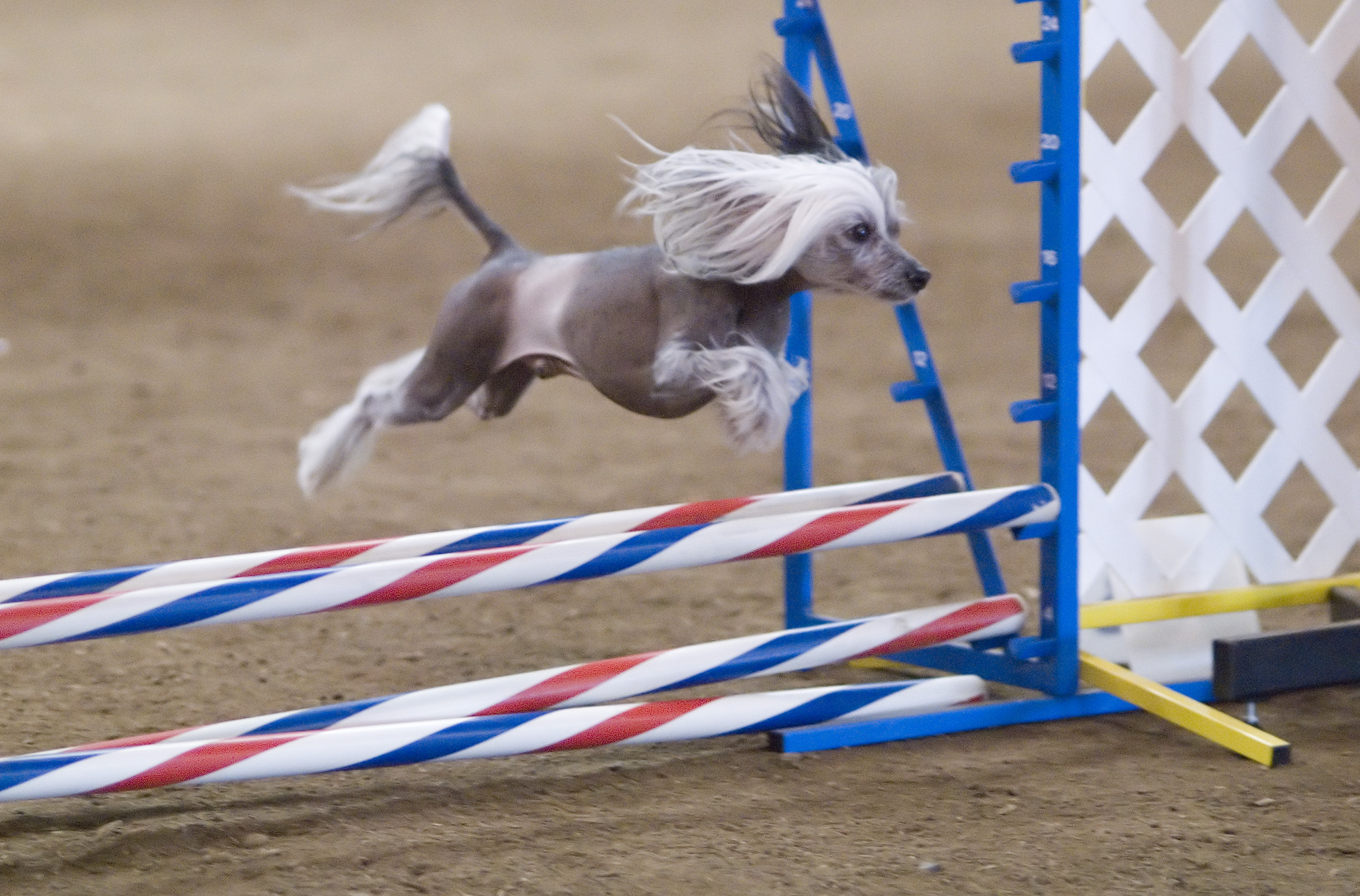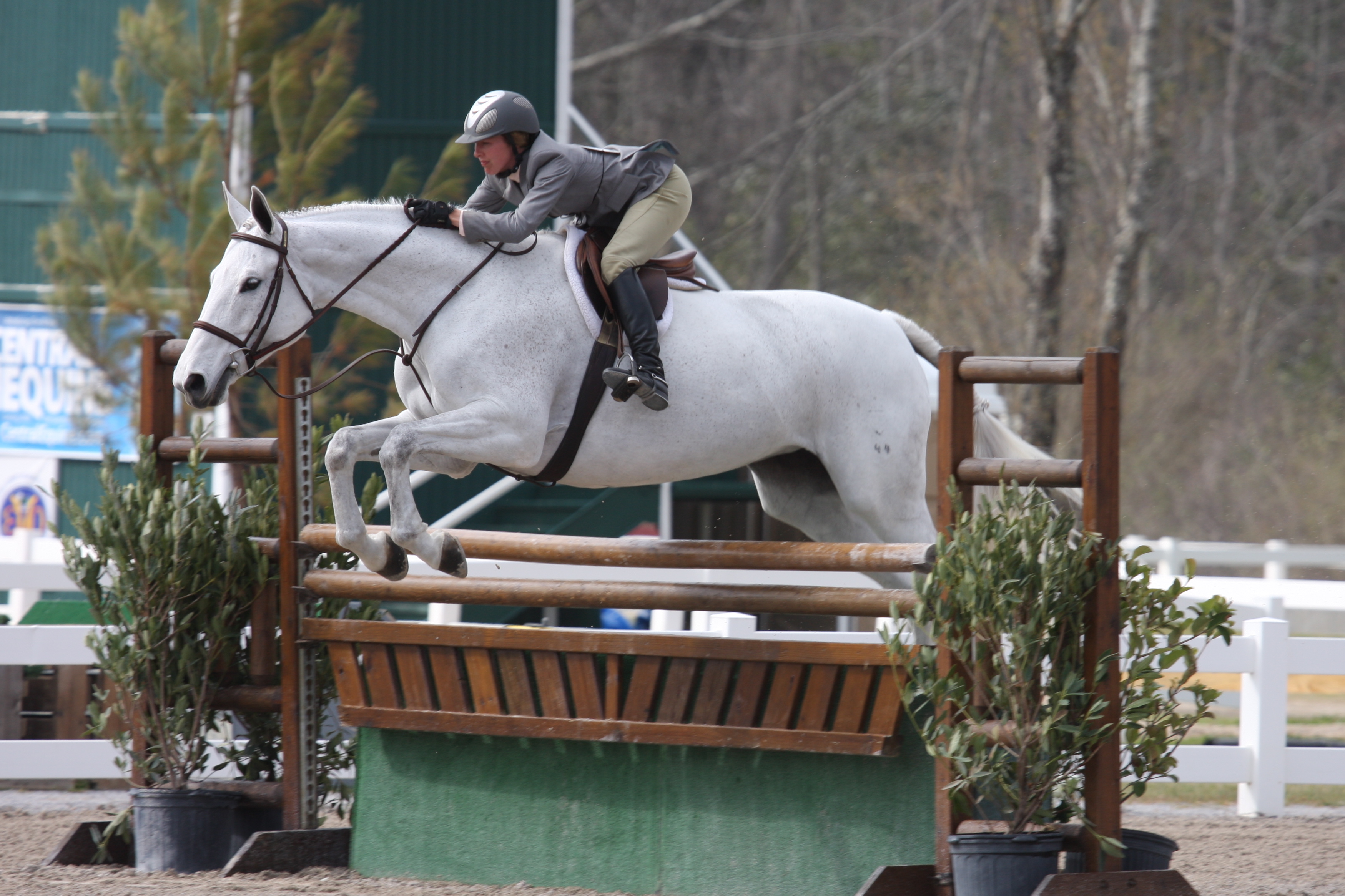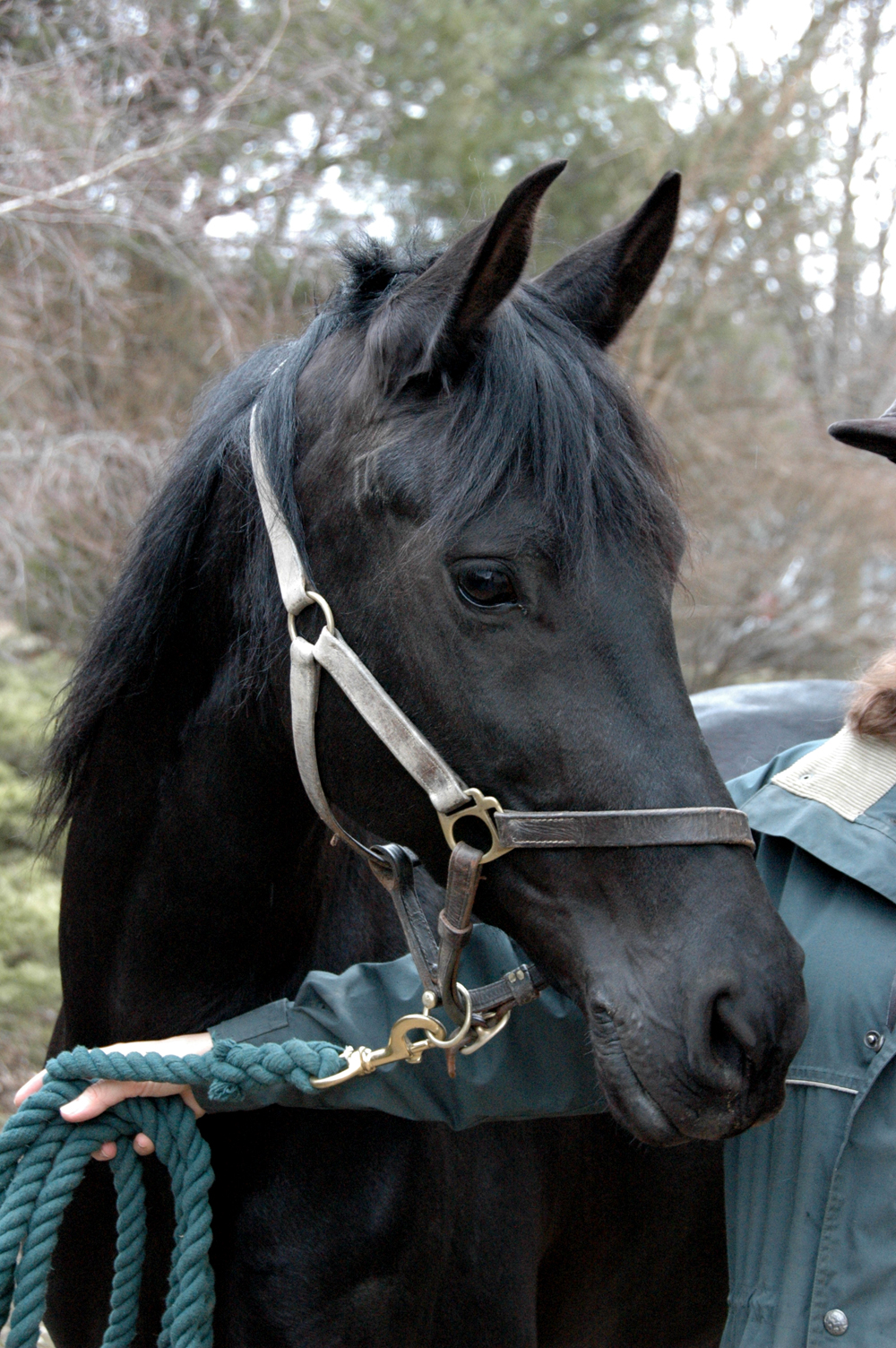|
Equine Agility
Equine agility or horse agility is a sport similar to dog agility but using horses. Horses are asked to navigate an obstacle course with guidance from a human handler on the ground. At lower levels, the horse may be guided with a lead rope but at higher levels the horse works without a lead and in some cases, without a halter. There also are competition levels where horses compete in the "wild" — outside of an enclosed arena, and competitions where horses are not judged live but rather via video sent in by their handlers. Any equine of any size may compete in agility, including miniature horses, donkeys, mules and draft horses. In live competition, handlers are required to wear an equestrian helmet and cannot use whips or sticks. The horse is only allowed, at most, to wear a halter, lead rope and may wear leg protection such as splint boots. The lead rope must be loose and the handler cannot pull on it but must remain within a designated position with their horse. Competi ... [...More Info...] [...Related Items...] OR: [Wikipedia] [Google] [Baidu] |
Dog Agility
Dog agility is a dog sport in which a handler directs a dog through an obstacle course in a race for both time and accuracy. Dogs run off leash with no food or toys as incentives, and the handler can touch neither dog nor obstacles. The handler's controls are limited to voice, movement, and various body signals, requiring exceptional training of the animal and coordination of the handler. An agility course consists of a set of standard obstacles laid out by a judge in a design of their own choosing in an area of a specified size. The surface may be of grass, dirt, rubber, or special matting. Depending on the type of competition, the obstacles may be marked with numbers indicating the order in which they must be completed. Courses are complicated enough that a dog could not complete them correctly without human direction. In competition, the handler must assess the course, decide on handling strategies, and direct the dog through the course, with precision and speed equally impo ... [...More Info...] [...Related Items...] OR: [Wikipedia] [Google] [Baidu] |
Seesaw
A seesaw (also known as a teeter-totter or teeterboard) is a long, narrow board supported by a single pivot point, most commonly located at the midpoint between both ends; as one end goes up, the other goes down. These are most commonly found at parks and school playgrounds. Mechanics Mechanically, a seesaw is a lever which consists of a beam and fulcrum with the effort and load on either sides. Varieties The most common playground design of seesaw features a board balanced in the center. A person sits on each end, and they take turns pushing their feet against the ground to lift their side into the air. Playground seesaws usually have handles for the riders to grip as they sit facing each other. One problem with the seesaw's design is that if a child allows himself/herself to hit the ground suddenly after jumping, or exits the seesaw at the bottom, the other child may fall and be injured. For this reason, seesaws are often mounted above a soft surface such as foam, wood chi ... [...More Info...] [...Related Items...] OR: [Wikipedia] [Google] [Baidu] |
Show Hunter
The Hunter division is a branch of horse show competition that is judged on the horse's performance, soundness and when indicated, conformation, suitability or manners. A "show hunter" is a horse that competes in this division. Show hunters, ideally, show many qualities that were rewarded in the fox hunting field such as manners, fluid movement, and correct jumping style. They are shown in hunt seat style tack. Any breed can be exhibited, but at the highest levels they are usually of Warmblood or Thoroughbred type, though a hunter-style pony is also seen in youth classes. Some classes are restricted to horses of certain breeds or height. In the United States, show hunters are primarily exhibited over fences in various divisions, including Green Hunter, Working Hunter, Conformation Hunter and so on, with a few additional classes offered for horses shown in-hand or on the flat, known as "Hunter Under Saddle." In the United Kingdom, competition over fences is called "Working ... [...More Info...] [...Related Items...] OR: [Wikipedia] [Google] [Baidu] |
Show Jumping
Show jumping is a part of a group of English riding equestrian events that also includes dressage, eventing, hunters, and equitation. Jumping classes are commonly seen at horse shows throughout the world, including the Olympics. Sometimes shows are limited exclusively to jumpers. Sometimes jumper classes are offered in conjunction with other English-style events. Sometimes, show jumping is but one division of a very large, all-breed competition that includes a very wide variety of disciplines. Jumping classes may be governed by various national horse show sanctioning organizations, such as the United States Equestrian Federation or the British Showjumping Association. International competitions are governed by the rules of the International Federation for Equestrian Sports. Hunters or jumpers Show jumping events have hunter classes, jumper classes and hunt seat equitation classes. Hunters are judged subjectively on the degree to which they meet an ideal standard of ... [...More Info...] [...Related Items...] OR: [Wikipedia] [Google] [Baidu] |
Western Riding (horse Show)
Western Riding is a competitive event at American horse shows, particularly those for stock horse breeds such as the American Quarter Horse. It is not to be confused with the general term "western riding," referring to the many forms of equestrianism where riders use a western saddle; instead, it refers to a particular class where the horse and rider complete a pattern that incorporates elements of both reining and trail classes, but requiring horses to perform in a quiet style akin to that of a Western pleasure class. Horses are evaluated on “quality of gaits, lead changes at the lope, response to the rider, manners and disposition." While all three gaits are required, most of the pattern is performed at a lope. Emphasis is placed on the horse's smoothness, even cadence, and precise, clean flying lead changes. Procedure Each horse performs individually. There are usually four patterns from which a judge may choose, all containing a walk, a jog, a jog over a log, a ... [...More Info...] [...Related Items...] OR: [Wikipedia] [Google] [Baidu] |
Trail (horse Show)
Trail is a competitive class at horse shows where horses and riders in western-style attire and horse tack navigate a series of obstacles.Strickland ''Competing in Western Shows'' p. 45 Contestants ride the course one at a time. Originally designed to resemble situations a horse and rider might actually encounter when on a trail in a natural habitat, modern trail classes now tend to focus more heavily on agility and manners, with courses bearing very little resemblance to real-world natural trails. A typical trail course requires horse and rider to open and pass through a small gate while mounted; walk across a fake bridge; cross over a set of rails or logs at a walk, trot or lope; back up, often with a turn while backing; sidepass, often over a rail or log; turn on the forehand or hindquarters within a confined area; and tolerate some type of "spooky" obstacle, such as having the rider put on a vinyl raincoat. The horse is asked to perform all three gaits in the process of com ... [...More Info...] [...Related Items...] OR: [Wikipedia] [Google] [Baidu] |
Labyrinth
In Greek mythology, the Labyrinth (, ) was an elaborate, confusing structure designed and built by the legendary artificer Daedalus for King Minos of Crete at Knossos. Its function was to hold the Minotaur, the monster eventually killed by the hero Theseus. Daedalus had so cunningly made the Labyrinth that he could barely escape it after he built it. Although early Cretan coins occasionally exhibit branching (multicursal) patterns, the single-path (unicursal) seven-course "Classical" design without branching or dead ends became associated with the Labyrinth on coins as early as 430 BC, and similar non-branching patterns became widely used as visual representations of the Labyrinth – even though both logic and literary descriptions make it clear that the Minotaur was trapped in a complex branching maze. Even as the designs became more elaborate, visual depictions of the mythological Labyrinth from Roman times until the Renaissance are almost invariably unicursal. Branchin ... [...More Info...] [...Related Items...] OR: [Wikipedia] [Google] [Baidu] |
Horse Trailer
A horse trailer or horse van (also called a horse float in Australia and New Zealand or horsebox in the British Isles) is used to transport horses. There are many different designs, ranging in size from small units capable of holding two or three horses, able to be pulled by a pickup truck or SUV; to gooseneck designs that carry six to eight horses, usually pulled by 1-ton dually-style pickups. There are also large semi-trailers that can haul a significant number of animals. In the UK, a horsebox may also refer to a motorised vehicle adapted to carry horses (generally known as a horse van in North America or Australasia), or a railway vehicle specifically designed to carry horses. The least expensive type of trailer is the stock trailer, a trailer designed for cattle that is enclosed on the bottom, but has slits at roughly the eye level of the animals to allow ventilation. Trailers designed specifically for horses are more elaborate. Because horses are usually hauled for the ... [...More Info...] [...Related Items...] OR: [Wikipedia] [Google] [Baidu] |
Pole Bending
Pole bending is a timed event that features a horse and one mounted rider, running a weaving or serpentine path around six poles arranged in a line. This event is usually seen in high school rodeos and 4-H events as well as American Quarter Horse Association, Paint, and Appaloosa sanctioned shows as well as at many gymkhana or O-Mok-See events. Nez Perce Stake Race The Nez Perce Stake Race is a type of pole bending race which is also a match race: two horses race on identical courses laid out side-by-side, with the loser eliminated and the winner moving up the brackets to race the other winners. It is not a timed event. It is one of five game classes approved for horse club shows by the Appaloosa Horse Club The Appaloosa Horse Club, located in Moscow, Idaho, is dedicated to preserving and promoting the Appaloosa breed. The state of Idaho adopted the Appaloosa as its state horse in 1975. More than 630,000 Appaloosas have been registered with the Appal ... (ApHC). The ApHC ... [...More Info...] [...Related Items...] OR: [Wikipedia] [Google] [Baidu] |
Splint Boots
Brushing boots or splint boots are used to protect a horse's legs during exercise, protecting the lower leg from injury that may occur if one leg or hoof strikes the opposite leg. They are commonly seen on horses in fast work, such as jumping, when in training, such as when longeing, or in competitions such as reining or eventing. Brushing injuries are more common on the forelegs, when one hoof catches the other leg, or when the fetlock or cannon bones hit each other. This can cause a serious injury on a horse's legs, especially if the horse is wearing shoes. Poor equine conformation can often lead to brushing, although even properly-conformed horses can also accidentally injure themselves. Brushing boots may also be placed on horses in the field to protect them if they get overly excited. Other reasons for use may include placement on a young or unfit horse which may be excitable and step on itself, or on horses subject to intense work that may stumble more if they are tire ... [...More Info...] [...Related Items...] OR: [Wikipedia] [Google] [Baidu] |
Lead Rope
A lead, lead line, lead rope (US) or head collar rope (UK), is used to lead an animal such as a horse. Usually, it is attached to a halter. The lead may be integral to the halter or, more often, separate. When separate, it is attached to the halter with a heavy clip or snap so that it can be added or removed as needed. A related term, lead shank or lead chain refers to a lead line with a chain attached that is used in a variety of ways to safely control possibly difficult or dangerous horses if they will not respond to a regular lead. Variations A lead can be made from a variety of materials, including cotton, horsehair (woven or braided hair, usually from a horse's tail), leather, nylon or other synthetic materials. Lead ropes, as the name implies, are round and made of various types of rope, usually between 5/8 and 3/4 inch (about 2 cm) in diameter.http://www.sstack.com Halters and leads at Schneider's Saddlery Co. Lead lines are usually flat webbing or leat ... [...More Info...] [...Related Items...] OR: [Wikipedia] [Google] [Baidu] |
Whip
A whip is a tool or weapon designed to strike humans or other animals to exert control through pain compliance or fear of pain. They can also be used without inflicting pain, for audiovisual cues, such as in equestrianism. They are generally either a firm stick designed for direct contact, or a flexible line requiring a specialized swing. The former is easier and more precise, the latter offers longer reach and greater force. A hunting whip combines a firm stick (the stock or handle) with a flexible line (the lash or thong). Whips such as the "cat o' nine tails" and knout are specifically developed for flagellation as a means of inflicting corporal punishment or torture on human targets. Certain religious practices and BDSM activities involve the self-use of whips or the use of whips between consenting partners. Misuse on non-humans may be considered animal cruelty, and misuse on humans may be viewed as assault. Use Whips are generally used on animals to provide directiona ... [...More Info...] [...Related Items...] OR: [Wikipedia] [Google] [Baidu] |









